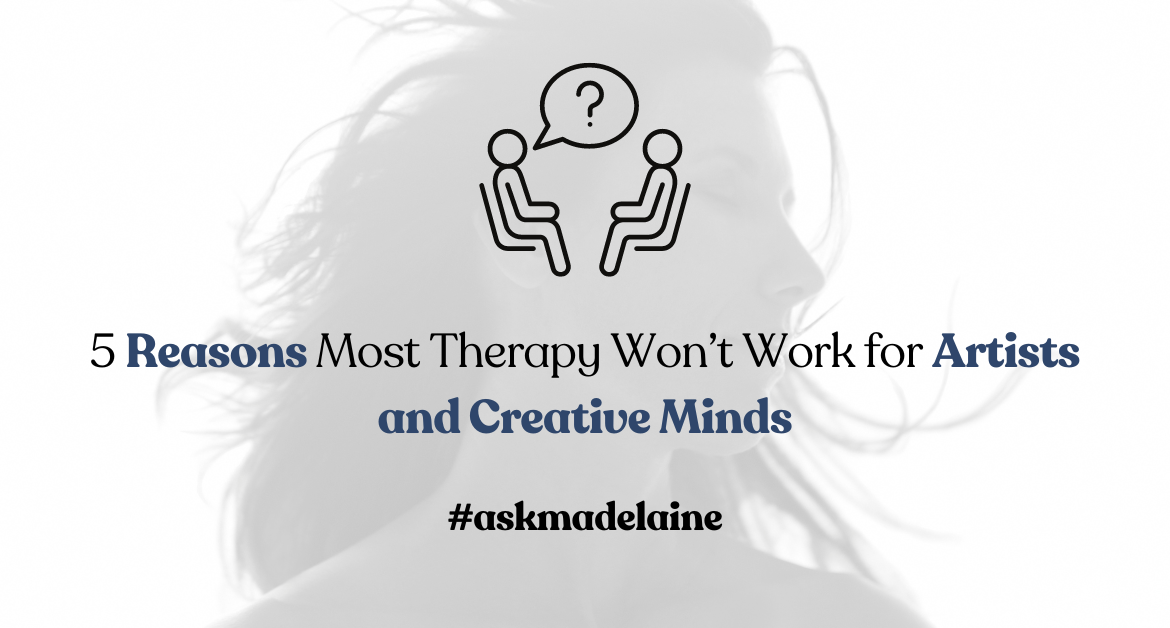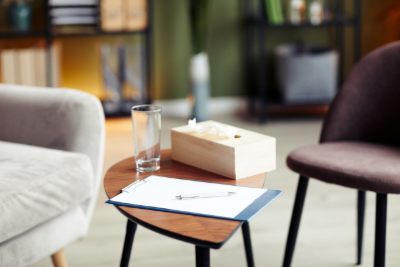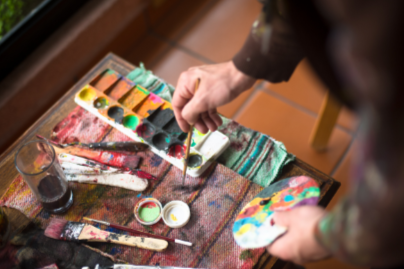

5 Reasons Most Therapy Won’t Work for Artists and Creative Minds (And What You Can Do About It)
I’m going to be brutally honest: most therapy just doesn’t cut it for artists and creatives. And I know because I live and breathe this world. I’ve sat in those therapy chairs, feeling the disconnect, the frustration, the sense that the person across from me just doesn’t get it. Traditional therapy isn’t built for the creative mind—it’s often too rigid, too fixated on “fixing” what doesn’t need fixing.
Artists don’t need to be put in a box; they need someone who understands that their brains are wired differently, that their way of seeing the world is a gift, not a problem. The conventional methods often fall flat because they simply don’t grasp how we’re wired. We’re different, and that difference is often misunderstood. This is one of the reasons I’m so passionate about helping creatives. We’re so often misinterpreted, pushed into frameworks that don’t fit, and told to seek balance when balance is the last thing we want.
Here’s why most therapy fails artists and creatives, and what you can do to get the help that actually works:
1. What the Hell Is Work-Life Balance?!
For us, work-life balance is a joke. Our art isn’t a nine-to-five gig; it’s a 24/7 immersion. We don’t clock out at the end of the day because there’s no dividing line between our work and our life—it’s all one continuous flow. Telling an artist to “balance” their work and life is like telling them to breathe less. It’s not just impractical; it’s an insult to the very nature of our being.
Therapists often preach the virtues of balance as if it’s a destination we need to reach. But for us, balance is a myth, a concept that doesn’t apply to the way we live and create. Our art isn’t just something we do; it’s who we are. The idea of compartmentalising it, of finding “balance,” strips away the essence of our creative drive.
2. Forget Death—We’re Terrified of Being Forgotten
Death doesn’t scare us—being forgotten does. We live with the constant drive to create something that outlasts us, something that leaves a mark on this world. We’re haunted by the thought of our work, our legacy, fading into obscurity. Therapy that doesn’t acknowledge this fundamental fear, that doesn’t tap into our obsession with legacy, is therapy that’s missing the point entirely.
The creative mind is obsessed with immortality through creation. Our art is our way of speaking to future generations, of ensuring that our voice echoes long after we’re gone. If a therapist can’t understand that our deepest fear isn’t dying but dying without leaving a legacy, then they’re not equipped to help us.
3. Stop Fixing Me—I’m Not Broken
There’s nothing more infuriating than a therapist who comes at us with the intention of “fixing” something. We’re not broken. The darkness we carry, the extremes we live in—they’re what make our art powerful. Trying to fix us is trying to erase the very things that fuel our creativity. We don’t need to be fixed; we need to be understood, to be honoured for who we are in all our complexity.
Artists don’t need to be put back together. We’re whole, even when we’re messy, chaotic, and living in extremes. Therapy that tries to smooth out those edges, to fix the darkness, is therapy that risks dulling our creative spark. We need therapists who see our intensity as a strength, not a flaw.
4. My Trauma Is Already Out There—It’s Called My Art
You want to talk about trauma? We already have, through every piece of art we’ve created. Our trauma, our pain, our deepest fears—they’re all out there on display in our work. Forcing us to rehash it in a clinical setting feels redundant, even intrusive. Our art is our therapy. If you can’t see that, you’re not just missing the point—you’re trampling on our process.
We’ve already laid our souls bare. Our trauma is woven into every brushstroke, every lyric, every line of dialogue we create. Therapy that asks us to relive it all over again can feel like a violation of the sanctuary we’ve built through our art. Instead of dragging us back through our pain, help us channel it into something transformative.
5. Balance? Please—I Live for the Extremes
The high of creation is what keeps us alive. We’re not in it for the steady, measured approach; we’re in it for the thrill, the intensity, the all-consuming passion. And yes, that comes with a crash, but it’s a price we’re willing to pay. Preaching balance to an artist is like telling a fire not to burn. We’re not interested in a balanced life—we’re addicted to the extremes, and trying to force us into a middle ground is like extinguishing our flame.
Living in extremes is part of the artistic experience. The highs of creation, the lows of completion, the constant oscillation between the two—that’s where we thrive. Therapy that pushes for moderation, that encourages us to flatten out those peaks and valleys, is therapy that’s missing the point. We don’t need to be taught balance; we need to be supported in our extremes.
Honouring the Creative Brain—And Confronting the Tortured Artist
Our brains are wired differently, and that difference should be honoured, not pathologised. The creative mind is a beautiful, complex, and often chaotic thing, capable of bringing something entirely new into existence. But with this gift comes a darker side—the tortured artist who lives for the highs and spirals into despair when the creation is done.
We’ve all heard the stories—artists who fall into depression, addiction, or worse because they can’t handle the extremes they live in. The truth is, it doesn’t have to be this way. We don’t have to conform to traditional methods that don’t understand us, but we also don’t have to destroy ourselves for our art. There’s a middle ground where we can honour our creative process without being consumed by the darkness that often accompanies it.
The idea that suffering is necessary for great art is a dangerous myth. It’s a narrative that romanticises pain and can lead us down a path of self-destruction. While our creativity is often fuelled by intense emotions, we don’t need to live in constant turmoil to be great artists. If we truly want to leave a lasting legacy, we need to be alive and well to continue creating.
Getting the right support isn’t about dulling our creativity—it’s about protecting our ability to create by learning how to manage the extremes. It’s about challenging the idea that we must suffer to produce meaningful work and understanding that our legacy is built not just on what we leave behind, but how we live while we’re here.
So How Can Artists And Creatives Get the Support They Need?
If you’re a creative looking for therapy that actually works, don’t settle for someone who tries to fit you into a box. Here’s how to find the right support:
1. Ask About Their Framework: Does the therapist have a framework that respects the creative process? Do they see your creativity as a strength rather than a flaw?
2. Check Their Track Record: Have they worked with other creatives? Are they creatives themselves? Do they understand the highs and lows of the creative mind?
3. Align on Values and Beliefs: Make sure their values align with yours. Are they okay with extremes, or are they pushing you toward some idea of normalcy that doesn’t fit your life?
4. Demand Respect for Your Process: Don’t settle for someone who doesn’t see your art as a legitimate form of therapy. Your creative process is your lifeblood, and any therapist who doesn’t understand that isn’t worth your time.
5. Look for a Partner, Not a Fixer: Therapy should be a partnership, not a repair job. Find someone who’s willing to walk with you through the highs and lows, who respects your need for intensity, and who understands that being an artist isn’t something to be cured—it’s something to be celebrated.
You don’t have to conform to get the support you need. The right support is out there—you just need to find someone who gets that your creativity isn’t a problem to be solved but a gift to be nurtured.
PLUS – Whenever you’re ready, there are 2 ways we can work together:
- Sign up for one of our current courses at ASHC and get taught by my team of advisors and me. All our courses are internationally and nationally industry-approved and will equip you with all the tools to open up your own professional private practice.
- Apply for one of only three spots as my private client.



Leave a Reply